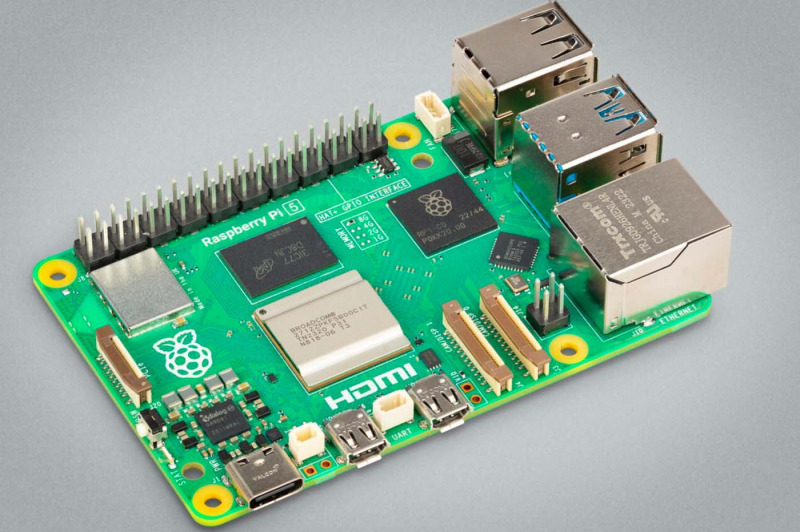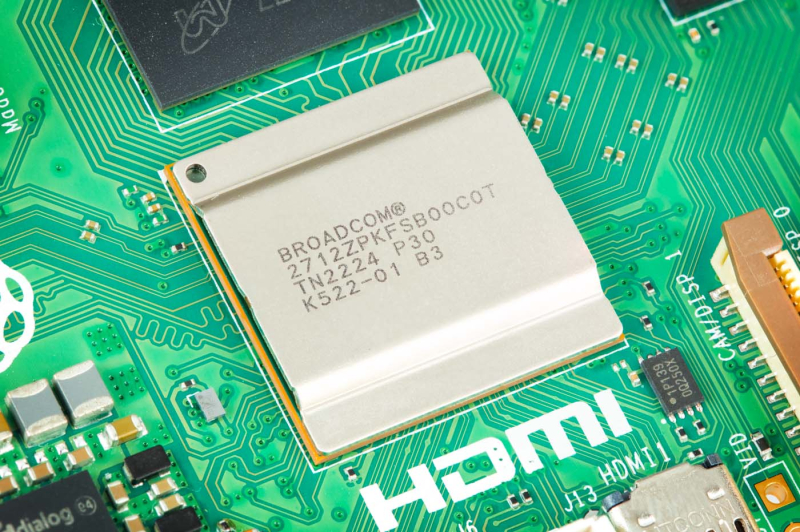
The Raspberry Pi 5 are the next generation of small embedded computers for electronics enthusiasts (and low-cost computing). The interest of these devices, in addition to their small size and reduced energy consumption, lies both in the presence of GPIO ports and the possibility of installing a real operating system – all with USB ports, an Ethernet port, and a WiFi chip right out of the box.
In many ways it is an alternative to dev boardsArduino, except that these are designed around the idea that you can directly launch C code (translated into machine language) to carry out a few specific tasks in an ultra-optimized way whereas a Raspberry Pi is really a more general complete computer, therefore a little less efficient from an energy point of view for very specific projects.
But which may however be suitable for more complex projects requiring, among other things, an interface, to be able to control a signal/play video, or control packets on the network in response to changes in voltage on the GPIO pins among other examples. The Raspberry Pi 5 now comes with a new 64-bit ARM chip clocked at 2.4 GHz, with a GPU that supports OpenGL and Vulkan as well as 4K video up to 60 frames per second.
< p>We invite you to know everything about the Raspberry Pi 5 in this file.
For the moment the Raspberry Pi 5 is not yet available in France, but according to the firm, it should arrive by the end of October 2023. The wait will therefore no longer be very long.
The miniature computer will be offered in two RAM variants:
- Raspberry Pi 5 4GB: $60 excluding tax*
- Raspberry Pi 5 8GB: $80 excluding tax*
* Prices are indicative rates in dollars provided by the firm. The official prices in euros are not yet known, but given the close exchange rate of the euro and the dollar, we can expect similar prices in euros.
| CPU< /td> | – ARM – Broadcom BCM2712 2.4GHz (64 bit) – Cortex-A76 – Cryptographic extensions – 512 KB L2 cache per core – 2 MB shared L3 cache |
| RAM | 4 GB/8 GB LPDDR4X-4267 SDRAM- |
| GPU | – VIDEOCORE VII – 2x 4-channel MIPI transceivers at 1.5 Gbps – Video up to 4K60fps – HDR – OpenGL – Vulkan |
| Storage | – via microSD – Support for SDR104 high bandwidth mode |
| USB ports< /td> | – 2x USB 3.0 (up to 5 Gbps each simultaneously) – 2x USB 2.0 |
| Ethernet | – 1x GbE with PoE |
| Wireless connectivity | – WiFi 802.11ac dual band – Bluetooth 5.0 – BLE |
| Interfaces | – GPIO 40 pins – 2x MIPI transceivers – PCIe 2.0 (via Hat M.2 or other adapter |
| Power | – 5V/5A via USB-C – PoE |
The Raspberry Pi 5 embodies many advances compared to the previous generation without sacrificing its ultra-compact format. Overall compared to the Raspberry Pi 4B model, the Generation 5 CPU goes from 4 Cortex-A72 cores clocked at 1.8 GHz to 4 Cortex-A76 cores clocked at 2.4 GHz.
The GPU upgrades to a VIDEOCORE VII clocked at 800 MHz from 500 MHx and it now supports Vulkan 1.2. The new chip also allows simultaneous display in 4K60fps on two screens compared to just one. The RAM is faster, as is the internal memory (which would now also support NVME SSDs via a Hat M.2). GPIO Pins do not change for greater compatibility.

© Raspberry
As we can see, the new Raspberry makes a real leap in terms of CPU and GPU rates. We have 600 MHz CPU cores that are faster than on the Raspberry PI 4. An appreciable improvement, whether to use this machine alone or in more complex projects.
The VIDEOCORE VII GPU is also a plus for compatibility with various codecs and formats. With the notable arrival of support for Vulkan 1.3 (compared to 1.0 on the previous version). We can now display 4K60fps videos on up to two screens simultaneously.
The new chip also enables improved speeds of up to 5 Gbps simultaneously on both USB 3.0 ports. There is also the arrival of a PCIe connection which allows you to connect NVME SSD drives in place of the microSD card for internal storage.
Wireless connectivity does not don't change
From this point of view, the characteristics are strictly the same as the previous generation. We therefore have WiFi ac, Bluetooth 5.0, two fairly fast technologies (with BLE support). However, if you had problems with these interfaces on generation 4 you will find the same limitations on the most recent generation.

© Raspberry
This aspect will impact users differently, but the new chip with its improved performance needs more current to work. So, in certain cases, if energy and/or autonomy is a problem, it would be better to stay on a Raspberry 4 (or try to use Arduino dev boards instead, which clearly consume less energy than this one). full ARM micro computer).
Note that because of this increased power, you may need to purchase a new, more powerful 5V/5A USB Type C adapter. Be careful, because this also means that if you use the CPU and GPU a lot, there will be a lot of heat dissipation. Therefore, an active cooling solution may be necessary in certain projects.

